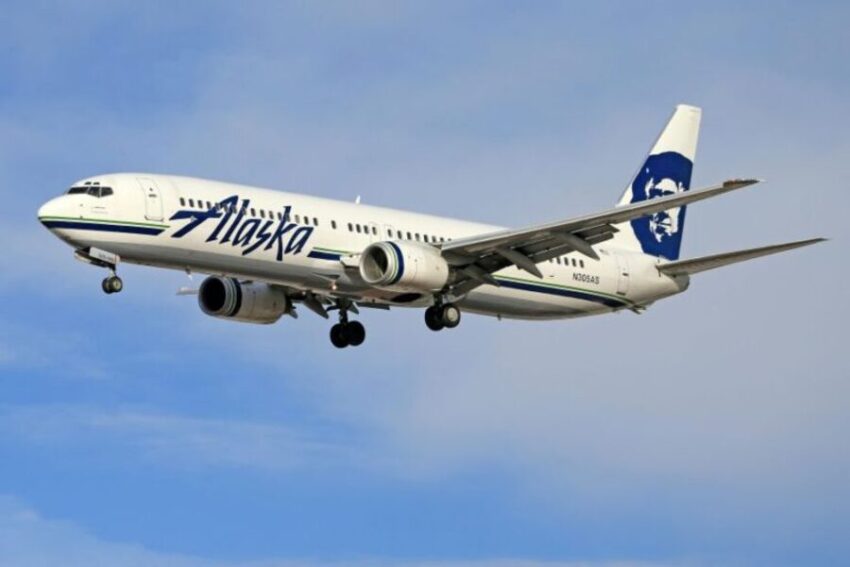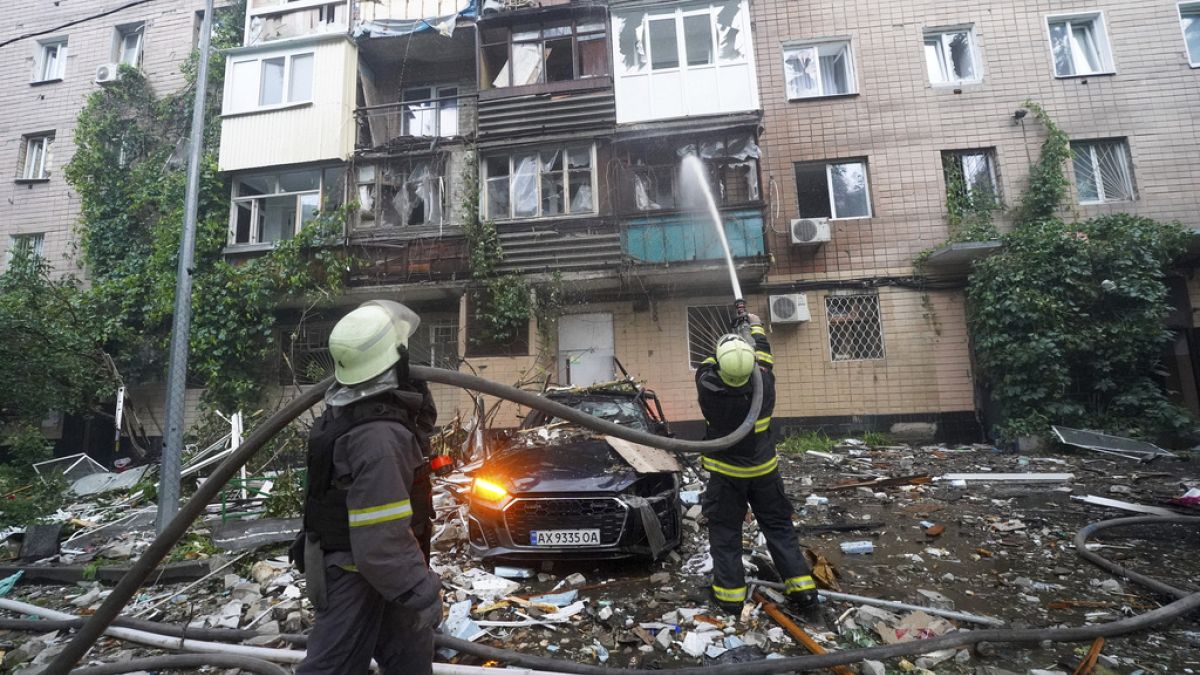Alaska
How’s the weather up there? It’ll be harder for Alaska to tell as longtime program goes off air

ANCHORAGE, Alaska — Before Morris Nashoanak heads out for days in search of bearded seals, beluga whales or salmon, he catches the weather on TV.
But it’s not the weather segment from a local TV station — there isn’t one. Instead, it’s a program designed for those living in rural and largely roadless Alaska, with separate forecasts for mariners, aviators and residents to help decide whether they can safely hunt, fish or fly.
“Alaska Weather” has been must-see TV for 47 years in a state where extreme weather dictates everyday life. But the daily program, the only weather show produced by the National Weather Service, will have its last on-air broadcast Friday, with business considerations ending its distribution to public television stations in Juneau and Fairbanks.
From then on, it will be available only on YouTube. That’s prompted fears that some of the state’s most vulnerable residents — those in far-flung Indigenous communities where internet service is unreliable, or who are older and uncomfortable getting information from a phone or computer — will be left on the wrong side of Alaska’s vast digital divide.
In Stebbins, a Yup’ik village of about 630 residents on St. Michael Island in the Bering Strait, Nashoanak said the internet is slow and can cut out for days at a time. The program informs Nashoanak, and other Alaska Native residents allowed to hunt and fish for subsistence under federal law, whether it’s worth spending over $6 per gallon of gas to fire up ATVs or boats.
“It’s critical and beneficial for many of us … something we can depend on,” said Nashoanak.
Alaska Public Media has traditionally provided the show via its Fairbanks station to the Alaska Rural Communication System, a series of state-owned, low-power transmitters that broadcast free programming across much of rural Alaska.
Carrie Haisley, chief of emergency services and the multimedia branch for the National Weather Service in Anchorage, Alaska, works with meteorologist David Percy in the service’s makeshift TV June 21, 2023. The “Alaska Weather” program she oversees, the only weather show produced by the National Weather Service, will have its last on-air broadcast Friday after Alaska Public Media dropped distribution, forcing it to YouTube. Credit: AP/Mark Thiessen
But Alaska Public Media in January said it would discontinue distribution unless it could secure $50,000 a year from the federal government. The weather service’s parent agency, the National Oceanic and Atmospheric Administration, agreed to come up with the money, but the network conducted a subsequent review showing that its total annual costs were actually $200,000.
“It made it impossible for us to come up with a path forward that would work,” said Carrie Haisley, chief of the Anchorage National Weather Service’s emergency services and multimedia branch.
Linda Wei, Alaska Public Media’s chief content officer, said the network simply can’t keep distributing the show for free.
“It’s no longer sustainable for us to continue in this manner,” she said. “It’s not a decision that we came to lightly.”

In this June 21, 2023, photo, meteorologist David Percy films the daily “Alaska Weather” program in a makeshift studio at the National Weather Service office in Anchorage, Alaska. The “Alaska Weather” program she oversees, the only weather show produced by the National Weather Service, will have its last on-air broadcast Friday after Alaska Public Media dropped distribution, forcing it to YouTube. Credit: AP/Mark Thiessen
Allan Eustis was the show’s first anchor when it went on the air in 1976. The Lancaster, Pennsylvania, resident learned how appreciative people were for the program when he visited Alaska’s distant villages.
“A lot of them use the information to go out whaling during whaling season, and we would show satellite pictures of where the ice was,” he said of the federally allowed subsistence hunt. “If there’s a reason to continue the show, it really would be to support these folks.”
Eustis and his successors did the show live every day at Alaska Public Media’s studios until 2017, when the station decided it could use that space differently, Haisley said.
Production switched to the weather service’s office in Anchorage, where a small closet was cleared out for a mini TV studio complete with a green screen and a camera.
Two meteorologists produce the weather show 365 days a year, creating forecasts and maps and filming the program in three segments. Those are sent to Alaska Public Media, where technicians compile the 30-minute program.
Now, the three forecast segments will be uploaded to a National Weather Service YouTube channel.
Rick Thoman, a climate specialist at the International Arctic Research Center at the University of Alaska Fairbanks, called the end of the on-air broadcast a shame.
“If you don’t have good internet connectivity, you’re in a world of hurt in western and northern Alaska as far as getting weather information,” he said.
During a visit to Alaska last month, first lady Jill Biden touted the government’s efforts to address connectivity inequities in the nation’s largest state, particularly in Alaska Native villages. On Monday, the government announced another $1 billion to help build broadband infrastructure in Alaska.
But it will take time to build that network across unforgiving terrain. Even when there is a strong internet link, things can go wrong.
Earlier this month, about 20,000 Alaskans along the northern and western coasts lost their internet when ice scouring the floor of the Beaufort Sea cut a fiber optic cable. Ships can’t arrive to fix it until the sea ice melts, likely in early August.
“The information distribution in rural Alaska has been narrowed into this one communication channel called the internet that people have a very difficult time getting to,” Thoman said. “No matter how tech savvy you are, if your internet’s out, you can’t get it.”
Both the weather service and Alaska Public Media said they are open to further discussions.
Haisley also solicited public comment from rural residents, looking for other ways the weather service can deliver the information, with some suggesting radio programs or a podcast. Neither of those support graphics, however.
“We’ve relied for so long in this partnership with Alaska Public Media to use TV as a medium to do that, and there doesn’t seem to be another way that really fills the gap,” she said.

Alaska
OPINION: Planned Parenthood is crucial to protecting Alaska survivors of trafficking and MMIR

How we care for the most vulnerable among us defines who we are as a society. In Alaska, where resources are limited and disparities are deep, continued Medicaid eligibility for Planned Parenthood is not just important — it is essential to the safety, health and survival of our communities, especially for survivors of violence, human trafficking and in addressing the ongoing crisis of our Missing and Murdered Indigenous Relatives (MMIR). Planned Parenthood plays a crucial role in supporting survivors locally and nationally.
Planned Parenthood offers a safe, confidential, and trauma-informed environment — one of the few places where survivors of violence can access essential services without shame or fear. In Alaska’s vast and often isolated regions, this access can be life-saving. Their providers understand the deep connection between reproductive healthcare and abuse: how coercion, control and violence make it difficult for survivors to advocate for their own bodies or get the care they need. Planned Parenthood’s mission-driven prioritization of immediacy is essential to Alaskans in crisis, or those who, due to control and coercion, have little ability to control their own freedoms and schedules. Same-day appointments at Planned Parenthood are often the best choice for survivors, who do not have the luxury of scheduling out their healthcare and waiting weeks for appointment times.
Planned Parenthood provides vital services like STI and HIV testing, emergency contraception and screenings for IPV and trafficking. Equally important, their providers are trained to recognize the signs of abuse and exploitation, including human trafficking, and can serve as a trusted first point of contact. Many survivors take their first steps toward safety because a Planned Parenthood provider helped them access legal support, advocacy, housing, or crisis intervention.
Equally important is the role they play in prevention. Through education about consent, bodily autonomy, and healthy relationships, Planned Parenthood empowers patients to understand and navigate their own lives. For many, Medicaid is the only option for healthcare — especially for those whose abusers or traffickers have restricted access to income, transportation or documentation. In my work with survivors, I’ve seen time and again how Planned Parenthood, through Medicaid eligibility, became their only consistent and accessible source of care.
As a mental health provider, I refer to Planned Parenthood because they embody culturally responsive, compassionate care. They meet people where they are — whether in crisis, recovery, or survival — and provide a bridge to medical, mental health, and community resources.
The connection between human trafficking and MMIR is urgent and undeniable. Indigenous people face some of the highest rates of violence in the U.S., yet legal, jurisdictional and systemic barriers often prevent them from seeking protection. When healthcare becomes financially or geographically inaccessible, the risks of violence, disappearance, and death increase. Planned Parenthood is a trusted provider in Alaska, often offering an increased sense of privacy for those who live in close-knit and small rural communities. Their services offer culturally informed, trauma-sensitive care, creating a safety net for Indigenous people and others navigating dangerous situations.
Without Medicaid eligibility, that safety net collapses. Removing it would not only create dangerous gaps in care — it would actively increase the vulnerability of those already at highest risk. Continued Medicaid eligibility for Planned Parenthood is not just a healthcare issue — it is a public safety necessity. Survivors rely on low-barrier, trauma-informed services to access care without fear, shame, or financial hardship. Removing this access would strip away one of the few consistent lifelines available to those navigating violence and exploitation. If we are truly committed to building a safer, more just Alaska, we must ensure that all people — especially those at highest risk — can access care that honors their dignity, safety, and humanity. Preserving Medicaid eligibility for Planned Parenthood is essential to supporting survivors and safeguarding our communities with the respect they deserve.
I hope Sens. Murkowski and Sullivian vote no on the proposed 2025 Federal budget reconciliation bill, HR 1, and hold the best interests of Alaskans at heart.
Josie Heyano is an Alaska Native woman from Tanana and Ekuk, and a licensed mental health provider. She is the founder and executive director of Signify Consulting, and a nationally recognized subject matter expert on human trafficking.
• • •
The views expressed here are the writer’s and are not necessarily endorsed by the Anchorage Daily News, which welcomes a broad range of viewpoints. To submit a piece for consideration, email commentary(at)adn.com. Send submissions shorter than 200 words to letters@adn.com or click here to submit via any web browser. Read our full guidelines for letters and commentaries here.
Alaska
US Seattle Airport Plunged Into Chaos After Alaska Airlines Passenger Issues Direct Threat Leading To Runway Closures And Flight Cancellations – Travel And Tour World

Sunday, June 15, 2025

US Seattle Airport was thrown into a full-blown security crisis when a passenger aboard an Alaska Airlines flight issued a chilling mid-taxi threat that forced an immediate emergency ground stop, complete runway shutdowns, and massive police mobilization. The terrifying incident brought airport operations to a standstill, triggered flight cancellations and diversions, and unleashed widespread chaos as emergency teams raced to neutralize the threat and secure the aircraft while passengers were evacuated and subjected to heightened security screening.
Seattle Airport Thrown Into Chaos as Passenger Threat Forces Emergency Ground Stop and Massive Security Response
Seattle-Tacoma International Airport was plunged into sudden turmoil on Saturday afternoon when a serious security scare unfolded aboard an Alaska Airlines-operated Horizon Air flight. The situation triggered the immediate closure of two runways, caused significant disruptions to flight operations, and drew a fast, coordinated response from various security forces and law enforcement agencies.
The alarming chain of events began just as the Horizon Air flight was preparing for departure to Walla Walla. According to officials, while the aircraft was still taxiing and had not yet taken off, a passenger allegedly made what authorities described as a “direct threat to the safety of the aircraft” during a conversation with a flight attendant. The gravity of the passenger’s words immediately raised red flags for the crew, who promptly notified ground control and airline security.
Without delay, air traffic controllers ordered the aircraft to halt its taxiing and redirected it away from the terminal to a secure location on the tarmac. Emergency response teams, including Port of Seattle Police, fire units, and specialized security personnel, quickly surrounded the aircraft to contain the situation and ensure the safety of everyone on board.
The Port of Seattle confirmed that as the situation unfolded, two of the airport’s major runways were shut down as a precaution, while inbound flights were temporarily halted or diverted. The incident sent shockwaves through the airport’s operations, causing widespread delays, flight cancellations, and ripple effects across Sea-Tac’s busy flight schedule. According to airport officials, at least six scheduled flights were canceled entirely, and two incoming flights were forced to divert mid-air to alternate airports.
Alaska Airlines disclosed in an official statement that as the aircraft was taxiing for takeoff, a passenger verbally made a serious threat to the safety of the flight while speaking with a member of the cabin crew. Following protocol, the aircraft was immediately redirected, and authorities were contacted.”
Although authorities have not disclosed the exact details of the threat, law enforcement officials emphasized that the seriousness of the passenger’s remarks required a full-scale security response to mitigate any potential danger. The suspect, whose identity remains undisclosed pending investigation, was taken into custody without any further incident. No injuries were reported among passengers or crew members.
After the arrest, Port of Seattle Police and federal security teams boarded the aircraft to conduct a thorough inspection. Meanwhile, passengers were carefully escorted off the plane and underwent secondary security screening procedures as an added layer of precaution. Each passenger was re-screened by Transportation Security Administration (TSA) personnel before being allowed to continue their journeys or rebook alternate flights.
TSA officials, in coordination with the Port of Seattle authorities, conducted a meticulous search of the aircraft to ensure no other security risks were present. The affected airplane will remain grounded until it successfully passes a full security clearance process conducted under enhanced safety protocols.
The sudden security alert not only disrupted normal airport operations but also triggered heightened concerns among travelers and airport staff. Seattle-Tacoma International Airport, a major gateway on the West Coast, was running close to full capacity at the time of the incident, intensifying the scale and complexity of the emergency operation.
Airline passengers throughout the airport reported long lines, extensive delays, and gate changes as airport officials worked tirelessly to minimize the broader operational fallout. While some travelers expressed frustration over missed connections and canceled flights, most acknowledged the necessity of the precautionary measures taken by the authorities to ensure safety remained the top priority.
A spokesperson for the Port of Seattle later addressed the media, stating: “Safety is our utmost concern. In this case, swift action by the flight crew, airport personnel, and law enforcement helped bring the situation under control quickly and without injury.”
While such incidents are rare, they highlight the importance of constant vigilance and the critical role that airline crew and airport security play in safeguarding passengers. Officials commended the Alaska Airlines crew for their professionalism and immediate response, which allowed for a controlled and coordinated intervention.
As of now, the investigation remains ongoing, and additional details regarding the passenger’s identity, motives, and the exact nature of the threat have not yet been publicly released. Authorities have confirmed that federal agencies, including the FBI, are involved in the ongoing inquiry.
US Seattle Airport descended into chaos after an Alaska Airlines passenger issued a terrifying mid-taxi threat, forcing an emergency ground stop, full runway closures, mass flight disruptions, and a rapid police lockdown.
The incident serves as a stark reminder of the complex security challenges facing modern air travel and underscores the need for robust safety protocols that can quickly respond to unpredictable situations. For passengers at Seattle-Tacoma International Airport on Saturday, it was a sobering demonstration of how swiftly travel plans can be upended when safety concerns arise mid-operation.
Alaska
Track and field state champions staying close to home highlight second round of Alaska’s high school senior signings

The University of Alaska Anchorage has become a popular destination for some of the state’s top track and field talent over the past two years. Many of them opted to become Seawolves instead of venturing out of state to continue their athletic careers.
There were 23 Alaskans on the program’s roster for the 2025 season, and 20 of them were underclassmen who joined the team in the last couple of years. Now, the number of elite homegrown talents on the team is set to increase for the third year in row as several local products have committed to be part of the Green and Gold’s 2025-26 recruiting class.
Among this year’s crop of incoming talent is a quartet of recently crowned state champions.
Ketchikan’s Jason Lorig is a three-time state champion in the Division I boys 100 meter race, and set a state record as a junior. Lorig nearly broke his own record as a senior with a first-place time of 10.82.
“I really like Alaska, I like living here and it will be a good experience to run up there with a lot of new people from Alaska,” he said.
Lorig started talking to the Seawolves coaching staff around October and was sold after he visited the campus.
“I really liked their program and I liked the coach and they produce a lot of talent there,” he said.
Lorig cited incredible success stories such as Joshua Caleb, who rewrote program and GNAC records over the past two years, as a major selling point.
“I think it’d be good for me to go up there,” Lorig said.
Homer’s Gracie Miotke won the Division II girls 100-meter race at state with a personal and school record time of 12.51. She was also on the Mariners’ 4×200 and 4×100 relay teams that claimed state titles and broke more school records in the process. However, her principal event at UAA will be women’s hurdles.
“I’m super excited to keep competing in Alaska,” she said. “I know that they have a super great program and I can’t wait to go run with them.”
Miotke started talking to the Seawolves this past winter, beginning with assistant coach Ray Shadowens. She went on an official visit and even after going to look at some other schools, UAA just felt like the right fit.
“I committed in November and haven’t looked back since,” Miotke said.

Bartlett’s Tyler Drake claimed his first Division I boys state title in the 110-meter hurdles this past season. The previous year as a junior, he came up short to multi-time state champion and 2023 Gatorade Player of the Year A.J. Szewczyk. Szewczyk, who is coming off his freshman year with the program, will soon be a teammate of Drake’s.
“I’m just so excited to compete in Alaska with all these athletes,” Drake said. “I think the top seven best (senior) athletes in the state are all going to UAA. It’s just such a great feeling knowing that we’re going to help build up the UAA program. It’s already at a great point, I just can’t wait to make it an even greater program.”
Seeing athletes he grew up with and recently competed against already in the program, Drake believes joining the UAA roster will essentially be like competing on an “Alaskan all-star team.”
“You’re competing against them all the time and not just one meet,” he said.
Drake started talking to the staff at the end of last year, and in February, he called up a coach and let him know that he was set on becoming a Seawolf.
Chugiak’s Alliyah Fields capped off her prep career by successfully defending both of her titles in the 400 and 800 meter races and was the anchor on the 4×400 relay team that won a title as well, with a school-record mark.
“We all pulled through and I just did my job as an anchor leg and ran as hard as I could to close the gap,” she said. “I did not expect to break a school record, but it felt amazing.”
While Fields is sad to be hanging up her spikes as a Mustang, she is excited to lace them up as a Seawolf, and at UAA she’ll be honing her skills and pushing past her limits with many familiar faces.
“I am very grateful that I will be training alongside with athletes I’ve been competing against my whole high school career and finally call them my teammates,” she said. “I had the chance to talk to some of the talented athletes that will be attending UAA. They are very good people and we’re all looking forward to running with each other.”
Fields first met UAA head track and field coach Chas Davis during her junior season and kept in touch with him throughout the process. She committed after hearing some firsthand testimonials and endorsements from athletes already in the program.
“I knew I wanted to compete for UAA when I got to know some of my future teammates in person,” Fields said. “They were very helpful to tour me around their campus and talk about some of their programs and training facilities.”
Other 2025 graduates who have also committed to join the UAA track and field team include Sitka’s Marina Dill and Dimond’s Sarah Dittman and Avery Campbell.
The Anchorage Daily News asked coaches, parents and student-athletes to report individual college commitments. The following list is a compilation of those responses along with reporting from ADN sports reporter Josh Reed. If you know of a local student-athlete who could be included in a future article on college commitments, email jreed@adn.com or sports@adn.com.
Juneau-Douglas
Kai Ciambor will be competing in soccer at the University of Colorado-Colorado Springs in Colorado Springs, Colorado.
West
Beckett Stolp will be competing in track and field at Portland State University in Portland, Oregon.
Henry Carr will be competing in golf at Willamette University in Salem, Oregon.
Liam Hase will be competing in wrestling at Bismarck State College in Bismarck, North Dakota.
Piper Sears will be competing in cross country skiing at the University of Alaska Fairbanks.
Max Erickson will be competing in cross country running and track and field at the University of Alaska Fairbanks.
Merridy Littell will be competing in cross country skiing at Michigan Tech University in Houghton County, Michigan.
Marcus Walsted will be competing in cross country running and track and field at the University of Alaska Fairbanks.
Olivia Chichenoff will be competing in softball at Edgewood College in Madison, Wisconsin.
Dylan Sanders will be competing in football at Gustavus Adolphus College in St. Peter, Minnesota.
Colony
Kaidence Browning will be competing in softball at Farmingdale State College in Farmingdale, New York.
Ridge Spencer will be competing in football at College of Idaho in Caldwell, Idaho.
Chugiak
Alliyah Fields will be competing in track and field at the University of Alaska Anchorage.
Dimond
Aubree Ogee will be competing in softball at Mt. Hood Community College in Gresham, Oregon.
Ketchikan
Jason Lorig will be competing in track and field at the University of Alaska Anchorage.
Homer
Gracie Miotke will be competing in track and field at the University of Alaska Anchorage.
Bartlett
Tyler Drake will be competing in track and field at the University of Alaska Anchorage.
Service
Nevaeh James will be competing in basketball at Xavier University of Louisiana in New Orleans, Louisiana.
South
Jioni Walker will be competing in softball at Highline College in Des Moines, Washington.

Milly Wurst will be competing in softball at Ellsworth Community College in Iowa Falls, Iowa.
Catie Newall will be competing in softball at Shoreline Community College in Shoreline, Washington.
Bettye Davis East
Muhammed Sabally will be competing in basketball at University of Alaska Anchorage.
Deng Deng will be competing in basketball at University of Alaska Fairbanks.
Colony
Jonathan Figgins will be competing in football at University of Wisconsin-River Falls in River Falls, Wisconsin
Monroe Catholic
Shannel Kovalsky will be competing in basketball at Bellevue College in Bellevue, Washington.
Tucker Williams will be competing in basketball at Peninsula College in Port Angeles, Washington.
West Valley
Layla Fields will be competing in track and field at Central Washington University in Kittitas County, Washington.
Zaire Stebbins will be competing in football at Victor Valley College in Victorville, California.
Devillain Mataia will be competing in flag football at Tiffin University in Tiffin, Ohio.
Lathrop
LillyAnne (Ruby) Tansy will be competing in volleyball at the University of Alaska Fairbanks.
Neveah Moreland will be competing in basketball at Nelson University Arizona in Phoenix, Arizona.
Wayne Snowden will be competing in football at Central Lakes College in Brainerd, Minnesota.
Geronimo Talo will be competing in football at Central Lakes College in Brainerd, Minnesota.
Kodiak
Amaya Rocheleau will be competing in swimming at California State University-East Bay in Hayward, California.
Valdez
Romen Weber will be competing in wrestling at Minnesota North College-Itasca in Grand Rapids, Minnesota.
Angelo (AJ) Tudela will be competing in wrestling at Minnesota North College-Itasca in Grand Rapids, Minnesota.
Hoonah
Krista Howland will be competing in wrestling at Ottawa University in Ottawa, Kansas.
-

 West1 week ago
West1 week agoBattle over Space Command HQ location heats up as lawmakers press new Air Force secretary
-

 Technology1 week ago
Technology1 week agoThere are only two commissioners left at the FCC
-

 News1 week ago
News1 week agoA former police chief who escaped from an Arkansas prison is captured
-

 World1 week ago
World1 week agoUkraine: Kharkiv hit by massive Russian aerial attack
-

 News1 week ago
News1 week agoMajor union boss injured, arrested during ICE raids
-

 World1 week ago
World1 week agoColombia’s would-be presidential candidate shot at Bogota rally
-

 Technology1 week ago
Technology1 week agoXbox console games are suddenly showing up inside the Xbox PC app
-

 Technology1 week ago
Technology1 week agoMassive DMV phishing scam tricks drivers with fake texts




















